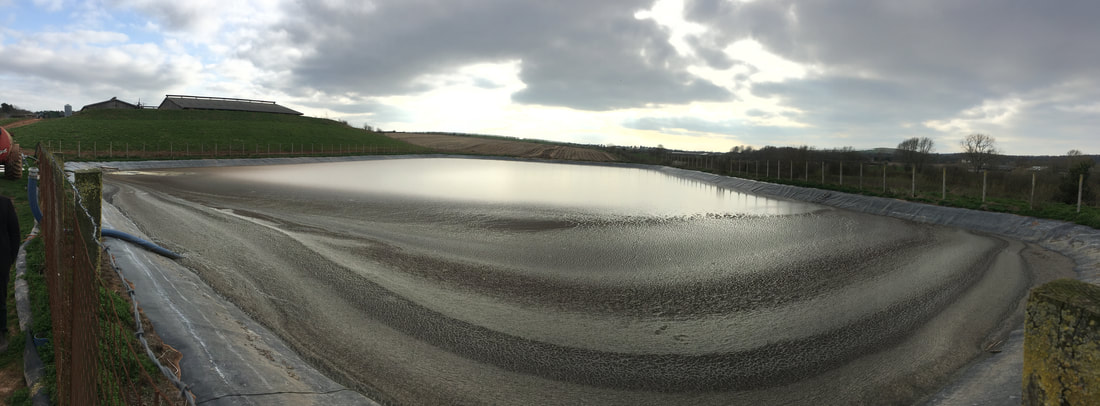 As part of their research, Daniel and his colleagues visited a UK dairy farm. Photo Credit: Daniel Gerber As part of their research, Daniel and his colleagues visited a UK dairy farm. Photo Credit: Daniel Gerber Air pollution has been described as one of the UK’s most severe public health challenges and also damages natural environments. One of the most concerning pollutants is ammonia: besides forming smog and particulate matter that can cause cardiovascular and respiratory disease, it also deposits excess nitrogen in habitats, which reduces biodiversity. Most (88%) of ammonia emissions originate from agriculture, particularly from manure and inorganic fertilisers. Worryingly, unlike other air pollutants such as nitrogen oxides, ammonia emissions are actually increasing and are consequently a key component of the UK Government’s 2019 Clean Air Strategy. But whilst government, industry and researchers agree this trend must be reversed, they face a key obstacle in doing so: measuring ammonia emissions remains no easy task indeed. “It is really important that we are able to accurately measure ammonia emissions from agriculture” says Daniel Gerber, of STFC Rutherford Appleton Laboratory. “At the moment, most UK studies use wind tunnels to measure ammonia emissions: these are typically 2 metres long and funnel air through a liquid acid, which is analysed later in a laboratory. Although this does work, it is slow and requires significant person power”. A physicist by training, Daniel’s work usually involves equipping space missions with highly sensitive instruments to detect radiation in outer space, rather than more ‘down to earth problems’. Indeed, Daniel wasn’t even aware of how severe the problem of ammonia emissions in the UK was until his group leader Brian Ellison (STFC RAL Space) attended a STFC Food Network+ Sandpit event in March 2018. Here he was introduced to Lizzie Sagoo from ADAS, an agricultural and environmental consultancy, who asked if his methods could be applied to measure ammonia emissions on the ground. This presented a stimulating challenge for Daniel and his colleagues: “Although our technology can detect ammonia in outer space, measuring it from earth is a completely different scenario. Since space is a vacuum, it is a benign environment for making measurements but in earth’s atmosphere you have other air particles, winds and temperature variations to contend with. We weren’t sure if it could work”. Brian and Lizzie submitted a proposal for an STFC Food Network+ Scoping Grant, to fund a project that would investigate if remote measuring of ammonia emissions was theoretically possible. This was ultimately successful and, starting at the very beginning, the team first worked out which, if any, radio frequencies could be used for detecting ammonia. Every molecule emits tiny radiowave signals, in the form of electromagnetic waves produced by charged particles within the atoms. The frequency of these waves is characteristic of the molecule’s structure; hence a specific gas can be measured by detecting the strength of its characteristic frequency signature. However, these signals can be weakened by other gases in the atmosphere, especially water vapour. This presents a compromise as Daniel explains: “Low frequency signals are less attenuated in the atmosphere but they also tend to be weaker to begin with, so are harder to detect”. Nevertheless, using models of the atmosphere and simulations, he and his colleagues identified a handful of signals that could be potentially viable. These results enabled them to secure a STFC Proof-of-Concept grant to start designing a prototype instrument. “We envisage that the instrument will be about the size of a small fridge, that could be towed into a field on a trailer or mounted on a wall” Daniel says. Crucially, it would be capable of measuring in real time, allowing it to detect any sudden surges in emissions which could then be investigated. A portable, easy-to-use instrument would also enable a much denser data map of ammonia emissions across the UK. This could ultimately help farmers make informed choices on when and how to spread manure and to assess whether current storage facilities adequately restrict emissions. These potential gains aptly illustrate the STFC Food Network+’s commitment to support projects that can deliver measurable impact towards a sustainable agricultural sector. “Without the STFC Food Network+, we would not have realised the value of an instrument to measure ammonia on the ground” Daniel says. He also stresses how important it was to interact with real people in order to truly understand what was needed. “Our conversations made us realise that ease of use and operation were more critical than using our space heritage to develop a supremely sensitive instrument. We were also able to visit a farm and see the conditions where it would be used: with dust in the air and mud everywhere, it was clear that this instrument couldn’t only be suited to a clean laboratory environment!” Besides the cognitive challenge, Daniel has enjoyed the rich experiences the project has brought. “I normally spend all day in clean offices, then suddenly I was pulling on wellies and wading through manure on farms…” he says. Despite the muck, he is keen to become involved in more interdisciplinary work. “This project has made me wonder how many other potential applications that we are not aware of could benefit from our technology… the challenge now is to connect with and meet those users.” After all, you can only begin to try and solve a problem once you know about it. It sums up the STFC Food Network+‘s ethos perfectly: bringing together those with a need with those that have a potential solution.
0 Comments
Your comment will be posted after it is approved.
Leave a Reply. |
AuthorJune 2024 - Archives
June 2024
Categories |
- Home
- Webinars and Events
- About the SFN+
- News
- Blog
- Expert Working Groups
- Funding
-
Publications
- Bioeconomy positioning paper
- SFN+ 5th Annual Conference
- OMM Policy Report
- ‘Multi-Stakeholder International One Day Workshop on Organic Agri-Food Value Chains for Net Zero’ Report
- SFN 2050 UK Net Zero Food report
- Sustainable Cold Food Chain Booklet
- Food Sensing Technologies for Safe and Nutritious Food
- Sustainable urban and vertical farming
- Projects
- Join/Contact Us


 RSS Feed
RSS Feed


